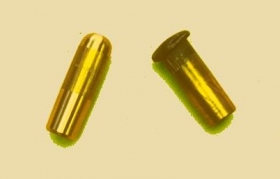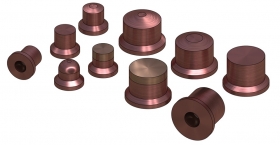
Electrodes
Questions and Answers
Improper weld current selection can cause problems during resistance welding. The problems normally show up in the form of expulsion, indentation, electrode sticking, mushrooming or low weld strength. There is an ideal current range for every resistance weld set up. This will produce good weld nuggets with little or no expulsion, modest indentation and minimal electrode wear or sticking. Whenever you push the extremes of the current in the weld window either high or low you risk problems.
Electrode face mushrooming is the normal wear mechanism of a spot welding electrode. To slow this process or prevent excessive mushrooming one must control several factors in the welding process.

EXTREME MUSHROOMING
Back up electrodes are used for projection welding electrodes. They are normally used on the lower side and are flat faced. There is no need for a defined weld face since the projection concentrates the weld current and heat into a desired spot for nugget creation.
Some resistance welding applications call out forces above the limits of tapered electrodes. The RWMA Manual Fig 18.3 shows force vs taper. It shows that above 2400 Lbs force tapers are not viable. Above this force specially designed High Pressure/High Force Electrodes must be used. These electrodes can be straight shanks, threaded or flanged electrodes. They are available from several manufacturers. Contact your electrode supplier for assistance.

Reference: RWMA Resistance Welding Manual 4th Edition
Class 14 material is a designation of the Resistance Welding Manufacturers Alliance (RWMA). It describes a pure Molybdenum material with good conductivity and excellent strength at high temperatures and forces. It is used as electrodes for cross were welding and electrobrazing.
Page 1 of 6
Have a Question?
Do you have a question that is not covered in our knowledgebase? Do you have questions regarding the above article? Click here to ask the professor.
